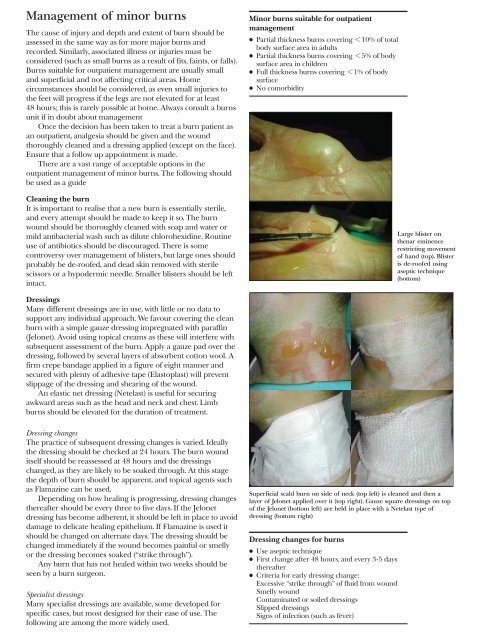ABC of Burns
Create successful ePaper yourself
Turn your PDF publications into a flip-book with our unique Google optimized e-Paper software.
Management <strong>of</strong> minor burns<br />
The cause <strong>of</strong> injury and depth and extent <strong>of</strong> burn should be<br />
assessed in the same way as for more major burns and<br />
recorded. Similarly, associated illness or injuries must be<br />
considered (such as small burns as a result <strong>of</strong> fits, faints, or falls).<br />
<strong>Burns</strong> suitable for outpatient management are usually small<br />
and superficial and not affecting critical areas. Home<br />
circumstances should be considered, as even small injuries to<br />
the feet will progress if the legs are not elevated for at least<br />
48 hours; this is rarely possible at home. Always consult a burns<br />
unit if in doubt about management<br />
Once the decision has been taken to treat a burn patient as<br />
an outpatient, analgesia should be given and the wound<br />
thoroughly cleaned and a dressing applied (except on the face).<br />
Ensure that a follow up appointment is made.<br />
There are a vast range <strong>of</strong> acceptable options in the<br />
outpatient management <strong>of</strong> minor burns. The following should<br />
be used as a guide<br />
Cleaning the burn<br />
It is important to realise that a new burn is essentially sterile,<br />
and every attempt should be made to keep it so. The burn<br />
wound should be thoroughly cleaned with soap and water or<br />
mild antibacterial wash such as dilute chlorohexidine. Routine<br />
use <strong>of</strong> antibiotics should be discouraged. There is some<br />
controversy over management <strong>of</strong> blisters, but large ones should<br />
probably be de-ro<strong>of</strong>ed, and dead skin removed with sterile<br />
scissors or a hypodermic needle. Smaller blisters should be left<br />
intact.<br />
Minor burns suitable for outpatient<br />
management<br />
x Partial thickness burns covering < 10% <strong>of</strong> total<br />
body surface area in adults<br />
x Partial thickness burns covering < 5% <strong>of</strong> body<br />
surface area in children<br />
x Full thickness burns covering < 1% <strong>of</strong> body<br />
surface<br />
x No comorbidity<br />
Large blister on<br />
thenar eminence<br />
restricting movement<br />
<strong>of</strong> hand (top). Blister<br />
is de-ro<strong>of</strong>ed using<br />
aseptic technique<br />
(bottom)<br />
Dressings<br />
Many different dressings are in use, with little or no data to<br />
support any individual approach. We favour covering the clean<br />
burn with a simple gauze dressing impregnated with paraffin<br />
(Jelonet). Avoid using topical creams as these will interfere with<br />
subsequent assessment <strong>of</strong> the burn. Apply a gauze pad over the<br />
dressing, followed by several layers <strong>of</strong> absorbent cotton wool. A<br />
firm crepe bandage applied in a figure <strong>of</strong> eight manner and<br />
secured with plenty <strong>of</strong> adhesive tape (Elastoplast) will prevent<br />
slippage <strong>of</strong> the dressing and shearing <strong>of</strong> the wound.<br />
An elastic net dressing (Netelast) is useful for securing<br />
awkward areas such as the head and neck and chest. Limb<br />
burns should be elevated for the duration <strong>of</strong> treatment.<br />
Dressing changes<br />
The practice <strong>of</strong> subsequent dressing changes is varied. Ideally<br />
the dressing should be checked at 24 hours. The burn wound<br />
itself should be reassessed at 48 hours and the dressings<br />
changed, as they are likely to be soaked through. At this stage<br />
the depth <strong>of</strong> burn should be apparent, and topical agents such<br />
as Flamazine can be used.<br />
Depending on how healing is progressing, dressing changes<br />
thereafter should be every three to five days. If the Jelonet<br />
dressing has become adherent, it should be left in place to avoid<br />
damage to delicate healing epithelium. If Flamazine is used it<br />
should be changed on alternate days. The dressing should be<br />
changed immediately if the wound becomes painful or smelly<br />
or the dressing becomes soaked (“strike through”).<br />
Any burn that has not healed within two weeks should be<br />
seen by a burn surgeon.<br />
Specialist dressings<br />
Many specialist dressings are available, some developed for<br />
specific cases, but most designed for their ease <strong>of</strong> use. The<br />
following are among the more widely used.<br />
Superficial scald burn on side <strong>of</strong> neck (top left) is cleaned and then a<br />
layer <strong>of</strong> Jelonet applied over it (top right). Gauze square dressings on top<br />
<strong>of</strong> the Jelonet (bottom left) are held in place with a Netelast type <strong>of</strong><br />
dressing (bottom right)<br />
Dressing changes for burns<br />
x Use aseptic technique<br />
x First change after 48 hours, and every 3-5 days<br />
thereafter<br />
x Criteria for early dressing change:<br />
Excessive “strike through” <strong>of</strong> fluid from wound<br />
Smelly wound<br />
Contaminated or soiled dressings<br />
Slipped dressings<br />
Signs <strong>of</strong> infection (such as fever)



